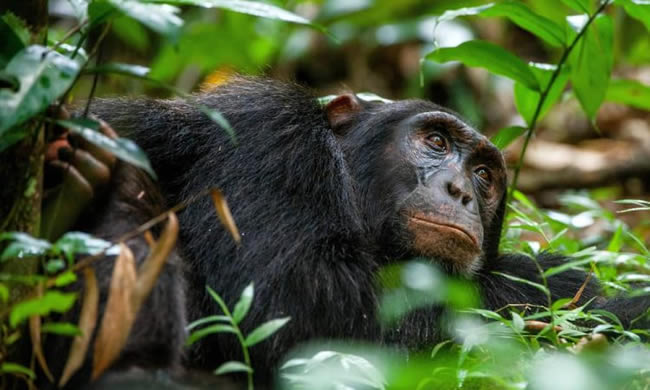The most fascinating characteristic of chimpanzees is; their nearly complete physical likeness with humans, and their DNA which is the closest in similarity to that of humans (over 98%). They live in groups known as “troops.” Each troop can host a population of about 50-100 chimpanzees. Locating them at times isn’t so complicated because they leave traces of their ground movements. Additionally, their chattering and incessant noise gives proper direction.
During chimpanzee trekking and habituation experiences, trekkers enjoy views of the chimpanzees as they groom, breastfeed their young ones, play, fight, sleep, kiss, eat tree leaves, and jump from one branch onto another. When the trekkers finally come closer to a troop of chimpanzees, they enjoy an hour of seeing them one-on-one, photography and even get to touch or take a selfie with some habituated chimps that tend to draw closer. It’s an awesome experience to say the least.
In Uganda, chimpanzees are hosted in these locations;
- Kyambura Gorge.
Kyambura Gorge is within Queen Elizabeth National Park. It is an underground forest that hosts hundreds of chimpanzees. It has a magnificent outlook with a forest within which focal location of these primates.
It is also home to a raging river i.e., Kyambura River which was named after this gorge. The Gorge is also crossed by the equator which adds to the flare within the enthusiasm of visitors that come to this place. While trying to locate this gorge, the pathways on upper ends give a beautiful scenery over the lower lands in valley. Besides chimpanzees, there are also other kinds of apes especially monkeys and baboons.
- Kalinzu forest.
It is located in the most forested western part of Uganda. Its biodiversity is quite flourishing and this forest is located on the sidelines of Queen Elizabeth National Park in Bushenyi district. It is also neighbored by the biodiverse Maramagambo forest.
Chimpanzee population in this forest is estimated to be about 350 individuals. There are more than 35 habituated chimpanzees which are available for chimpanzee tracking daily.
- Budongo forest.
Just as other counterparts highlighted and listed above, this forest equally lies in western Uganda. It is bordered by one of the most biodiverse conservation areas in north-western Uganda known as Murchison Falls National Park. It’s estimated to host about 700 chimpanzees that roam Budongo’s tropical wilderness.
Budongo is one of the least visited forests in Uganda, and this therefore gives off great space for tourists that visit the forest. Chimpanzee trekkers here get considerably more time compared to other chimpanzee tracking locations in Uganda.
- Kibale National Park.

This National Park is situated in western Uganda, largely composed of forest cover and low-lying ferns. Kibale forest is fairly dense with a mixture of montane and lowland vegetation. The pre-montane forest is known as the last such expanse in East Africa and world’s capital of primates with the biggest population of chimpanzees in the region.
In 1932, Kibale was gazetted as a national park by the then British Imperial administration and formal establishment of this park was in 1993. Kibale Forest is an extension of Queen Elizabeth National Park. It’s a natural forest whose significance has for decades seen national conservation efforts to protect the forest land, wildlife and chimpanzees that live beneath and in the canopies of high raising branches of its giant tropical trees.
How is chimpanzee trekking done?
Trekking these chimpanzees includes active hiking of the forest interior to where these primates are situated so as to have a once in lifetime glimpse.
In Kibale forest, this adventure commences from Kanyanchu visitor’s center and there are three daily trekking sessions – first trek group sets off at 8:00am, the second at 11:00am, and the last group sets off in the afternoon at 2:00pm. Those who participate in the earliest morning trek of 8 AM often get the best experience because chimpanzees will have arisen and freshly resting in open spaces.
There’s always a briefing session before any of the groups sets off in order to caution trekkers on the “Do’s and Don’ts,” what to expect from the trek, and get answers on the “Frequently Asked Questions.” The briefing is perfectly done by the Uganda Wildlife Authority and apart from the guides, rangers are also provided to each group for protection from any eminence of danger.
Chimpanzee trekkers are placed in groups of 6 members for each group. The assigned rangers are helpful with tracking the movements of these primates as they keep shifting from one ground onto another.
To take part in this experience, a visitor has to first secure a tracking permit. These are available at the Uganda Wildlife Authority offices but can be well reserved through a licensed tour operator.
What to carry?
While on the pursuit of taking part in chimpanzee trekking tours, visitors should carry a travel bags / backpacks in which to lift essentials such as a water bottle, power bank, camera and a pair of binoculars. A hat, insect repellent, comfortable long-sleeved shirt, well aerated trousers and effective hiking boots.
Best time to do chimpanzee trekking in Uganda.
Best time for this adventure is during Uganda’s dry seasons. These cut across the major regions of the country, as a consequence of being located in the tropics. Months of mid-June to early October give off the best sunlight, while the months of December to February are endowed with incredible sight-seeing opportunities.
However, these seasons may also be dependent on travelers themselves since some may have interests in trekking chimpanzees during the rainy seasons. However, the dry months / seasons as mentioned above are recommended.
